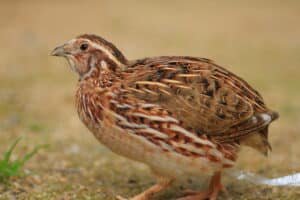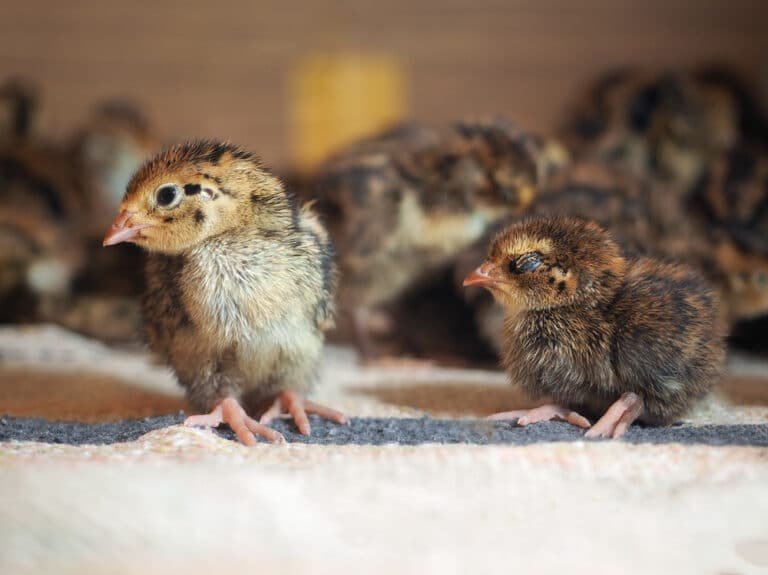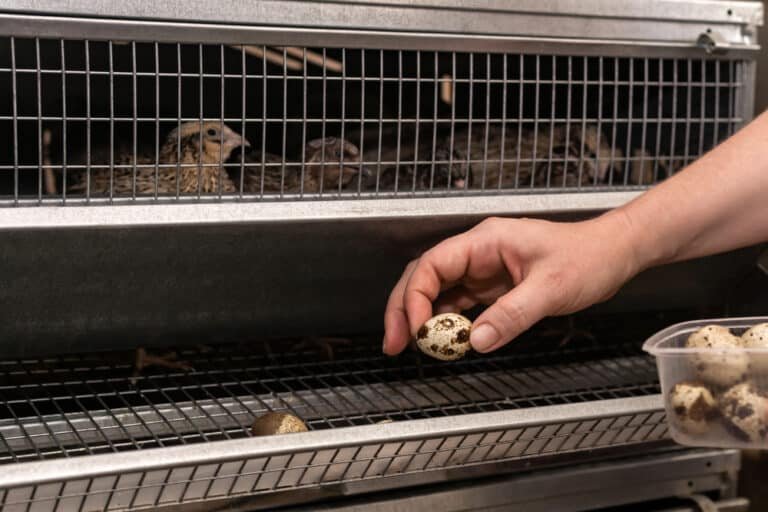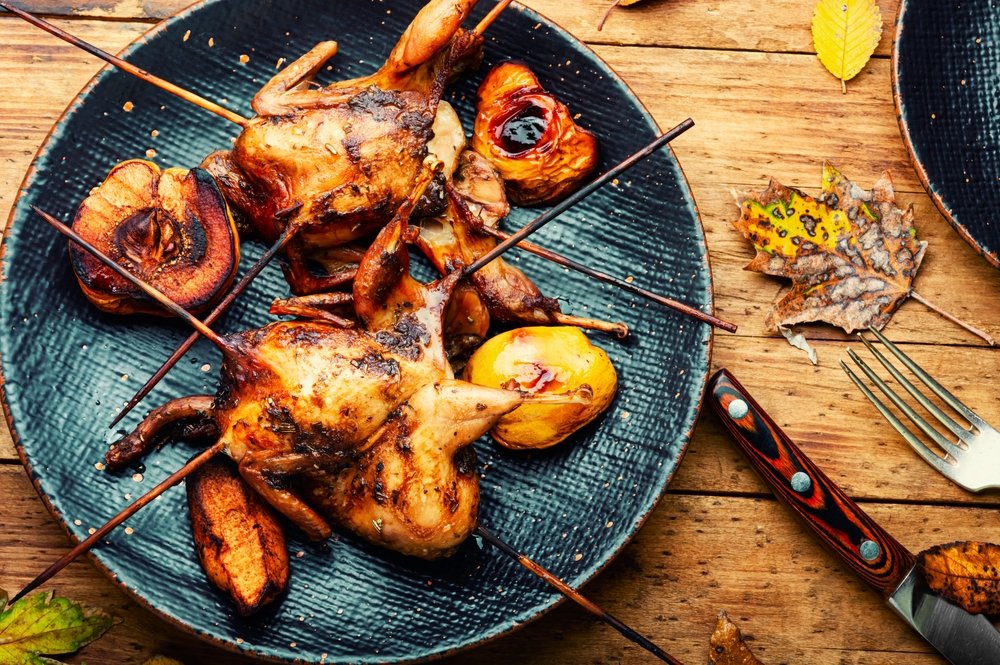Japanese Quail: Discover 5 Fascinating Facts
Japanese quail, scientifically known as Coturnix japonica, are small ground-dwelling birds that have captured the attention and interest of humans for centuries. This species belongs to the order Galliformes, which includes birds like chickens and pheasants. Japanese quail are native to East Asia and are widely distributed throughout countries such as Japan, China, Korea, and Russia.
Brief Overview of Japanese Quail (Coturnix japonica)
Japanese quail are renowned for their compact size and delicate appearance. Adult males typically measure about 6-7 inches long and weigh around 80-120 grams.
Females tend to be slightly larger than males, reaching lengths of 7-8 inches with weights ranging from 100-160 grams. These birds have a plump body with a rounded belly, short wings, and a relatively long tail.
A distinguishing feature of Japanese quail is their intricate plumage patterns. Males exhibit a beautiful combination of golden brown feathers on their backs with black stripes running vertically along their creamy-white chests.
Their heads showcase an elegant mix of dark brown or black hues with subtle white patches on the throat area. Female Japanese quail possess a more subdued feather coloration overall but retain similar striped patterns on their underbellies.
Their beaks are short and stout, perfectly adapted for cracking open seeds and grains – their primary diet components. Additionally, they have strong legs designed for swift movement on the ground and possess sharp claws that aid in scratching the soil while searching for food.
Importance of Japanese Quail in Various Fields
The significance of Japanese quail extends far beyond their aesthetic appeal or avian characteristics. These remarkable creatures play crucial roles in various fields, such as agriculture, research, and culinary traditions.
In agriculture, Japanese quail are highly valued for their rapid growth rate and efficient feed conversion into meat. Their relatively short lifespan allows for quick turnover in the production cycle, making them an ideal choice for farmers who require a consistent supply of eggs and meat.
The quail industry has witnessed substantial growth due to its high egg-laying capacity, with each female capable of producing over 200 eggs per year. Japanese quail are also extensively used in scientific research.
Their small size, ease of handling, and quick maturity make them popular subjects for studying genetics, physiology, behavior, and various diseases. These birds have contributed significantly to advancements in endocrinology and reproductive biology.
Furthermore, Japanese quail holds a special place in culinary traditions worldwide. They are considered a delicacy in many cultures due to their tender meat, which is rich in flavor.
Quail eggs are highly sought after as well; they are often used as an ingredient in gourmet dishes or served alone as bite-sized treats. The Japanese quail’s unique characteristics and multifaceted usefulness make it an intriguing subject worthy of exploration across various domains.
Taxonomy and Classification
The Intricate Classification of Japanese Quail
When delving into the world of taxonomy, we unravel the intricate hierarchy that classifies all living organisms. Japanese quail, scientifically known as Coturnix japonica, belongs to the domain Eukarya, which encompasses all organisms with cells containing a nucleus.
They further fall under the kingdom Animalia, a diverse group comprising multicellular organisms that exhibit locomotion and heterotrophic feeding habits. Within the Animalia kingdom, Japanese quail are classified under the phylum Chordata.
This species includes animals possessing a dorsal nerve cord and a supporting structure called the notochord during their embryonic development. The class Aves embraces our feathered friends—birds—who share distinct characteristics such as beak structure, feathers for flight or insulation, and laying hard-shelled eggs.
Moving along the taxonomic ladder, we find our quail grouped under the order Galliformes,, primarily consisting of ground-feeding birds characterized by medium to large body sizes and strong leg muscles adapted for terrestrial locomotion. Other familiar members of this order include pheasants, turkeys, grouse, and chickens.
Comparing Japanese Quail with Galliformes
While all Galliformes share certain commonalities in terms of anatomical features and ecological preferences, each species possesses unique attributes that distinguish it from its avian counterparts in this order. Among these fascinating birds stands our esteemed subject—the Japanese quail—which displays its distinct traits.
When comparing Japanese quail with other members of the Galliformes family tree, it becomes evident that they share similarities with some species but differ from others. For instance, they resemble other quail, like European quail (Coturnix coturnix), in terms of body shape and general appearance.
However, Japanese quail stands out due to their specific plumage patterns and coloration. Interestingly, Japanese quail also shows similarities to certain pheasant species (Phasianidae family) regarding reproductive behavior.
The female pheasants and Japanese quail can store sperm for extended periods, enabling them to mate with multiple males over time. This unique trait sets them apart from other members of the Galliformes order and contributes to their reproductive success.
By examining Japanese quail’s intricate taxonomy and classification, we gain a deeper understanding of their position within the animal kingdom. Their placement in the domain Eukarya, kingdom Animalia, phylum Chordata, class Aves, and order Galliformes highlights both their shared characteristics with other avian species and their distinctive features that make them truly captivating beings in their own right.
Physical Characteristics
Size and Weight Variations among different subspecies
Japanese quail, scientifically known as Coturnix japonica, exhibit subtle variations in size and weight across different subspecies. The average length of an adult male Japanese quail ranges from 15 to 20 centimeters (6 to 8 inches), while the females are slightly larger, measuring about 17 to 22 centimeters (7 to 9 inches) in length.
In terms of weight, males generally weigh between 100 and 150 grams (3.5 to 5.3 ounces), whereas females tend to weigh slightly more, ranging from 120 to 180 grams (4.2 to 6.4 ounces). It is important to note that these figures are approximate averages and can vary depending on factors such as subspecies, diet, and overall health.
Plumage Patterns and Coloration in Males and Females
The plumage patterns and coloration in male and female Japanese quail display distinct differences. Male quail possess a vibrant plumage characterized by a combination of earthy browns, grays, black outlines, and creamy white accents on their feathers. They showcase rich chestnut-colored throat patches with black stripes running vertically across their chest region.
Furthermore, males exhibit dark rufous-brown markings on their wings coupled with intricate black-and-white speckling on their backs. In contrast, female Japanese quail have more subdued coloration but remain beautifully marked nonetheless.
They typically feature a brownish or sandy-brown plumage with intricate black vermiculation across their bodies—a pattern resembling fine wavy lines or irregular curls. Their chest feathers are lighter in color compared to males but still exhibit some speckling.
Examination of Distinctive Features
Japanese quail possess distinctive features, including their beak shape and leg structure, that are specifically adapted to their environment and way of life. Their beaks are short and stout, providing them with precision while foraging for small seeds, insects, and other food sources in the wild.
The lower mandible of the beak typically has a slight curve that allows for efficient grasping and manipulation of various food items. Regarding leg structure, Japanese quail have strong legs relative to their body size.
Their legs are relatively short but well-muscled, enabling them to move swiftly on the ground. These birds have three forward-facing toes with sharp claws that aid in gripping different surfaces efficiently.
These features contribute to their agility when running or scratching through substrates like soil or vegetation in search of food. Overall, the physical characteristics of Japanese quail encompass variations in size and weight among subspecies, distinct plumage patterns between males and females, as well as specialized features such as beak shape and leg structure that facilitate their adaptation to specific ecological niches
Behavior and Social Structure
Social Hierarchy within a Flock or Covey of Japanese Quail
Within a flock or covey of Japanese quail, a fascinating social hierarchy emerges, revealing an intricate network of dominance and submission. Aggressive displays and physical interactions among the members predominantly determine this social structure. The dominant individuals, usually males, establish authority through aggressive behaviors such as pecking, chest bumping, and wing flapping.
They assert dominance by physically intimidating lower-ranking individuals and monopolizing resources such as food and nesting sites. Establishing the social hierarchy ensures order within the group, with each individual knowing its place in the pecking order.
Subordinate quail display submissive behaviors like crouching or moving away when approached by higher-ranking individuals. Maintaining social order helps prevent frequent conflicts and reduces stress within the flock.
A Detailed Explanation of Their Foraging Habits, Feeding Preferences, Roosting Behavior, and Vocalizations
Japanese quail exhibit diverse foraging habits that allow them to adapt to various environments. They are predominantly ground-dwelling birds that rely on animal- and plant-based food sources. Their diet consists of seeds, grains, insects, worms, small snails, and vegetation in their habitat.
With an omnivorous nature, they skillfully peck at the ground using their pointed beaks to unearth hidden prey or pluck seeds from plants. When it comes to feeding preferences, Japanese quail are known for their selective behavior towards certain types of foods.
They have a particular fondness for protein-rich insects during breeding seasons when they need additional energy for mating rituals and egg-laying activities. As dusk approaches, these quail exhibit remarkable roosting behavior, seeking shelter in dense vegetation or undercover to protect themselves from predators.
Their preferred roosting sites include grassy areas, shrubs, and low tree branches. This behavior also serves to conserve body heat during colder nights.
Communication among Japanese quail is primarily achieved through vocalizations. Males emit distinctive calls to attract females during courtship, characterized by repetitive and rhythmic notes.
Additionally, they produce warning calls to alert the flock of potential threats or predators. Females use softer calls to communicate within the group or express their receptivity towards males during mating season.
Overall, the behavior of Japanese quail showcases their adaptability, intricate social dynamics, and well-developed communication system, making them intriguing subjects for both scientific study and observation by poultry enthusiasts alike.
Habitat and Distribution
Habitat preferences for Japanese quail in East Asia
Japanese quail, scientifically known as Coturnix japonica, is naturally distributed in East Asia. Their native habitat includes diverse landscapes, including grasslands, open fields, scrublands, and agricultural areas. These adaptable birds are particularly prevalent in parts of China, Japan, Korea, and Russia.
In their natural range, Japanese quail often inhabit areas with ample vegetation cover that offers both suitable nesting sites and food sources. Within their native range, Japanese quail exhibit a preference for temperate climates.
They thrive in regions with distinct seasons characterized by moderate temperatures without extreme heat or cold. Water sources such as rivers or wetlands are also advantageous for these birds as they require hydration and suitable environments for breeding.
Adaptability to various environments worldwide
Thanks to human intervention through domestication efforts over centuries, Japanese quail has been successfully introduced to various environments across the globe. Their ability to adapt to different climates has played a significant role in their widespread distribution outside East Asia.
Domesticated Japanese quail have been selectively bred for traits such as increased egg production or superior meat quality. This deliberate breeding has led to the development of different strains or varieties that can be found today.
These domesticated strains possess heightened adaptive capabilities compared to their wild counterparts due to generations of controlled breeding programs emphasizing desirable characteristics. As a result of these adaptations and selective breeding efforts, Japanese quail are now found thriving in diverse habitats worldwide.
From Europe to North America and beyond, they have established populations even in regions vastly different from their original habitat. Their resilience and versatility make them adaptable birds capable of adjusting to varied environmental conditions relatively easily.
Overall, the successful colonization of Japanese quail outside of East Asia is a testament to their remarkable adaptability and the impact of human intervention in shaping their distribution. However, monitoring and managing these populations carefully is important to prevent any negative consequences on local ecosystems where they have been introduced.
Life Cycle and Reproduction
Captivating Courtship Displays and Mating Rituals
Japanese quail exhibit a fascinating array of courtship displays and intricate mating rituals that are captivating and crucial for successful reproduction. During the breeding season, which typically occurs in spring and summer, male quail engage in elaborate behaviors to attract potential mates. These displays include head bobbing, wing flapping, vocalizations, and puffing up their feathers to appear more attractive to females.
The males also engage in dueling behaviors, clashing their beaks together or engaging in rapid foot movements. Female Japanese quail closely observe these courtship displays before selecting their preferred mate.
Once a pair has formed, they engage in a unique bonding ritual called “billing.” This behavior involves the male gently pecking the female’s beak while emitting soft calls. This intimate interaction strengthens the pair’s bond and reinforces their commitment to successful breeding.
Egg-Laying Patterns, Incubation Period, and Hatching Process
After mating, female Japanese quail lay eggs within a carefully constructed nest or suitable nesting area. The female typically lays one egg daily until she reaches her clutch size of approximately 8-12 eggs. The eggs are small and oval-shaped with speckled markings that provide excellent camouflage within their natural habitats.
Following the completion of egg-laying, the incubation period begins. Female quail demonstrate remarkable dedication by incubating the eggs without assistance from the male.
Incubation typically lasts about 17-18 days as the female diligently maintains constant warmth by sitting on her eggs. As hatching approaches, tiny cracks appear on the shell surface as each chick inside begins to pip using its egg tooth—a small pointed structure located on its beak—to break through its confinement.
Gradually but surely, the chicks emerge from their shells, peeping softly and gradually drying their downy feathers. The hatching process usually takes several hours for all the chicks to break free from their protective eggs successfully.
Nature’s Mating Rituals Unveiled
The mating rituals of Japanese quail offer a captivating glimpse into the intricate dance of courtship in the avian world. From dazzling displays of physical prowess to tender bonding behaviors, these courtship rituals highlight the depth of commitment and communication between mates.
Regarding reproduction, Japanese quail follow an intriguing pattern that includes a meticulous egg-laying process and a dedicated incubation period. The female’s commitment to her clutch is admirable as she ensures optimal conditions for hatching while patiently waiting for her offspring’s arrival.
Witnessing these natural marvels unfold reminds us of the incredible diversity and complexity of nature’s propagation mechanisms. By delving into the life cycle and reproduction of Japanese quail, we gain a greater appreciation for these remarkable creatures and their place within the intricate tapestry of our natural world.
Genetic Variations
Like many other animal species, the Japanese quail exhibits genetic variations among different strains or breeds. These variations result from diverse factors such as geographical isolation, natural selection, and human intervention through selective breeding. When examining the genetic makeup of various strains or breeds of Japanese quail, scientists have identified differences in traits related to behavior, physical characteristics, and productivity.
Explanation of Genetic Variations Found Among Different Strains or Breeds
Japanese quail strains or breeds can vary significantly in their genetic composition. This variation can manifest in body size, feather coloration, egg production capacity, disease resistance, and overall vigor. For instance, some strains may possess genes that promote rapid growth and larger body size for meat production purposes.
On the other hand, certain breeds may exhibit specific color patterns on their feathers due to unique genetic markers. In addition to physical variations, genetic differences among Japanese quail strains are also responsible for diverse behavioral traits.
Some strains may display distinct courtship rituals or mating behaviors compared to others. These behavioral variations can impact social dynamics within a flock and influence reproductive success.
How Selective Breeding Has Led to Specific Traits such as Increased Egg Production or Meat Quality
Selective breeding plays a crucial role in shaping the desired traits of Japanese quail strains for improved productivity in terms of both egg production and meat quality. By intentionally selecting individuals with desirable characteristics over several generations, breeders have been able to enhance specific traits through genetic manipulation. In the case of increased egg production, breeders have selectively bred Japanese quail that lay eggs at a higher rate than their wild counterparts.
This process involves identifying individuals with high egg-laying potential based on their parentage and performance records and breeding them to produce offspring with even better egg-laying abilities. Over time, this has led to strains that consistently exhibit high levels of egg production.
Similarly, selective breeding has enhanced meat quality in Japanese quail. Breeders focus on selecting individuals with desirable traits such as faster growth rates, increased muscle mass, and improved meat texture and flavor.
By continually selecting and breeding individuals displaying these qualities, breeders have successfully developed strains optimized for meat production. Genetic variations among different strains or breeds of Japanese quail contribute to various characteristics, including physical appearance and behavior.
Through selective breeding practices, breeders have been able to refine specific traits such as increased egg production or improved meat quality. This intentional manipulation of genetic variations has played a vital role in shaping the Japanese quail’s economic significance in agriculture and ensuring its continued importance in various industries.
Economic Significance
Japanese Quails in the Agriculture Industry for Meat
Japanese quail have gained immense economic significance within the agriculture industry, primarily due to their high-quality meat. The tender and flavorful meat of these small game birds has captured the attention of culinary enthusiasts, leading to a growing demand in various cuisines worldwide.
Japanese quail meat offers a unique taste profile that sets it apart from other poultry options, making it an attractive choice for chefs and consumers. One significant factor contributing to the economic importance of Japanese quail in the meat industry is their impressive growth rate.
Compared to larger poultry species like chickens and turkeys, Japanese quail reach maturity much faster. This allows farmers to achieve higher turnover rates and maximize production capacity.
Additionally, these birds require less space and consume fewer resources, making them a cost-effective option for large-scale commercial farms and small-scale backyard breeders. Furthermore, Japanese quail eggs have also garnered attention for their potential health benefits.
While this section focuses on their economic significance for meat production, it’s worth mentioning that quail eggs are highly nutritious and are often sought after by health-conscious consumers. The versatility of Japanese quail as a dual-purpose bird adds another layer to their economic value within the agriculture industry.

Conclusion
Japanese quail have proven to be an economically significant player in the agriculture industry. Their delectable meat quality and efficient growth rates have made them an attractive option for producers looking to meet consumer demands while maintaining profitability.
As an adaptable species that can thrive in various environments, they offer flexibility in farming practices on small and large-scale commercial operations. Beyond their economic contributions, Japanese quail represent culinary diversity and cultural appreciation worldwide.
Their unique flavor profile provides chefs exciting opportunities to experiment with different cuisines, creating memorable dining experiences for food enthusiasts. With their versatility and economic viability, Japanese quail continue to positively impact the agriculture industry and gastronomic landscape, ensuring a promising future for these remarkable birds.






